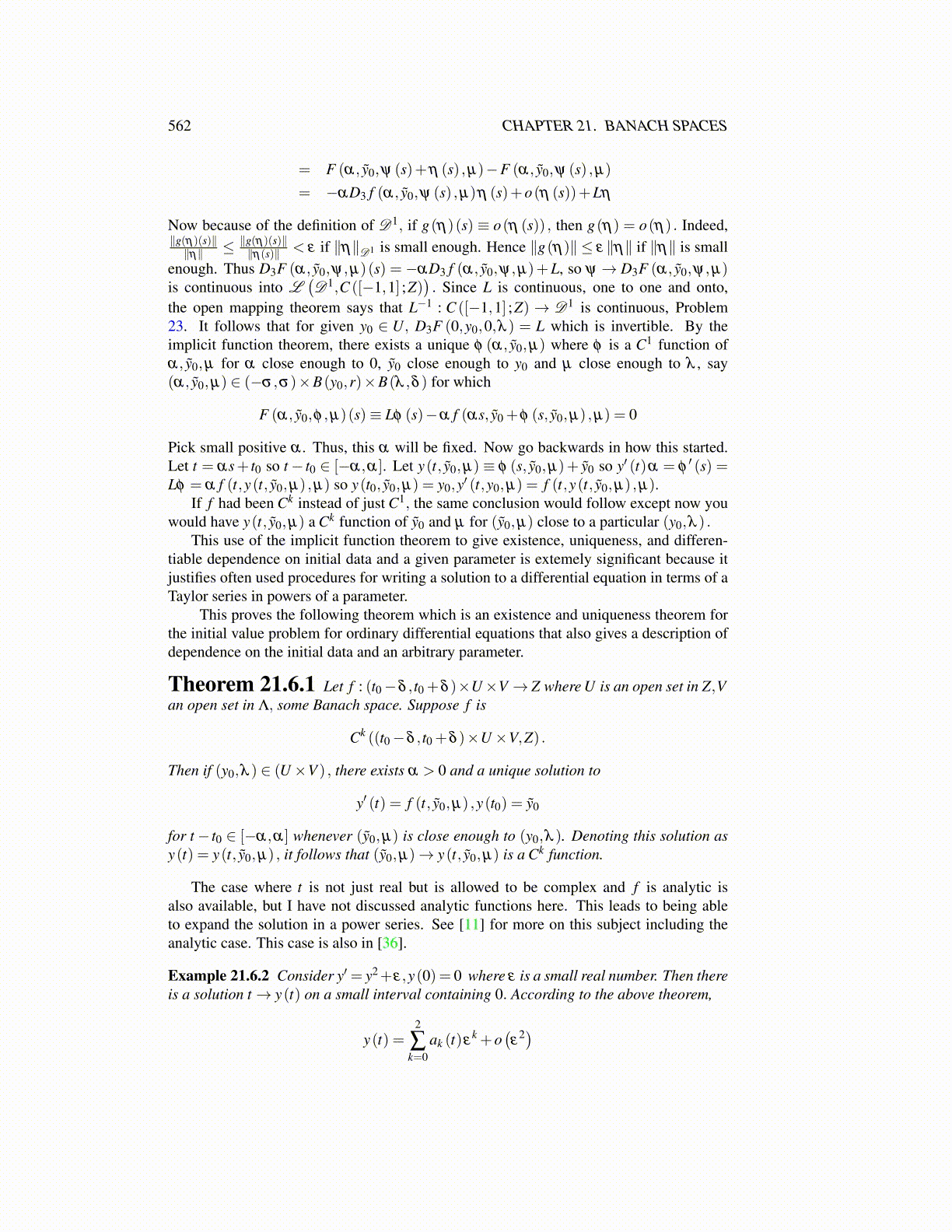
562 CHAPTER 21. BANACH SPACES
= F (α, ỹ0,ψ (s)+η (s) ,µ)−F (α, ỹ0,ψ (s) ,µ)
= −αD3 f (α, ỹ0,ψ (s) ,µ)η (s)+o(η (s))+Lη
Now because of the definition of D1, if g(η)(s) ≡ o(η (s)) , then g(η) = o(η) . Indeed,∥g(η)(s)∥∥η∥ ≤ ∥g(η)(s)∥
∥η(s)∥ < ε if ∥η∥D1 is small enough. Hence ∥g(η)∥ ≤ ε ∥η∥ if ∥η∥ is smallenough. Thus D3F (α, ỹ0,ψ,µ)(s) = −αD3 f (α, ỹ0,ψ,µ)+L, so ψ → D3F (α, ỹ0,ψ,µ)is continuous into L
(D1,C ([−1,1] ;Z)
). Since L is continuous, one to one and onto,
the open mapping theorem says that L−1 : C ([−1,1] ;Z) → D1 is continuous, Problem23. It follows that for given y0 ∈ U, D3F (0,y0,0,λ ) = L which is invertible. By theimplicit function theorem, there exists a unique φ (α, ỹ0,µ) where φ is a C1 function ofα, ỹ0,µ for α close enough to 0, ỹ0 close enough to y0 and µ close enough to λ , say(α, ỹ0,µ) ∈ (−σ ,σ)×B(y0,r)×B(λ ,δ ) for which
F (α, ỹ0,φ ,µ)(s)≡ Lφ (s)−α f (αs, ỹ0 +φ (s, ỹ0,µ) ,µ) = 0
Pick small positive α . Thus, this α will be fixed. Now go backwards in how this started.Let t = αs+ t0 so t− t0 ∈ [−α,α]. Let y(t, ỹ0,µ) ≡ φ (s, ỹ0,µ)+ ỹ0 so y′ (t)α = φ
′ (s) =Lφ = α f (t,y(t, ỹ0,µ) ,µ) so y(t0, ỹ0,µ) = y0,y′ (t,y0,µ) = f (t,y(t, ỹ0,µ) ,µ).
If f had been Ck instead of just C1, the same conclusion would follow except now youwould have y(t, ỹ0,µ) a Ck function of ỹ0 and µ for (ỹ0,µ) close to a particular (y0,λ ) .
This use of the implicit function theorem to give existence, uniqueness, and differen-tiable dependence on initial data and a given parameter is extemely significant because itjustifies often used procedures for writing a solution to a differential equation in terms of aTaylor series in powers of a parameter.
This proves the following theorem which is an existence and uniqueness theorem forthe initial value problem for ordinary differential equations that also gives a description ofdependence on the initial data and an arbitrary parameter.
Theorem 21.6.1 Let f : (t0−δ , t0 +δ )×U×V → Z where U is an open set in Z,Van open set in Λ, some Banach space. Suppose f is
Ck ((t0−δ , t0 +δ )×U×V,Z) .
Then if (y0,λ ) ∈ (U×V ) , there exists α > 0 and a unique solution to
y′ (t) = f (t, ỹ0,µ) ,y(t0) = ỹ0
for t− t0 ∈ [−α,α] whenever (ỹ0,µ) is close enough to (y0,λ ). Denoting this solution asy(t) = y(t, ỹ0,µ) , it follows that (ỹ0,µ)→ y(t, ỹ0,µ) is a Ck function.
The case where t is not just real but is allowed to be complex and f is analytic isalso available, but I have not discussed analytic functions here. This leads to being ableto expand the solution in a power series. See [11] for more on this subject including theanalytic case. This case is also in [36].
Example 21.6.2 Consider y′= y2+ε,y(0) = 0 where ε is a small real number. Then thereis a solution t→ y(t) on a small interval containing 0. According to the above theorem,
y(t) =2
∑k=0
ak (t)εk +o
(ε
2)